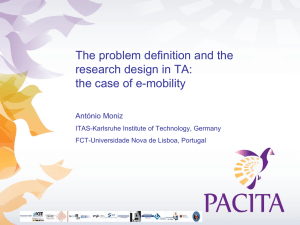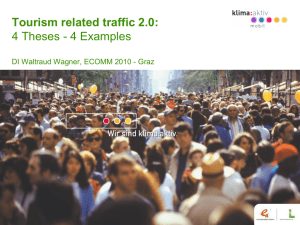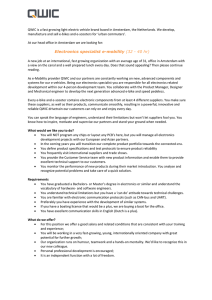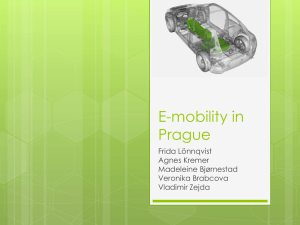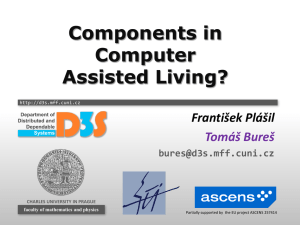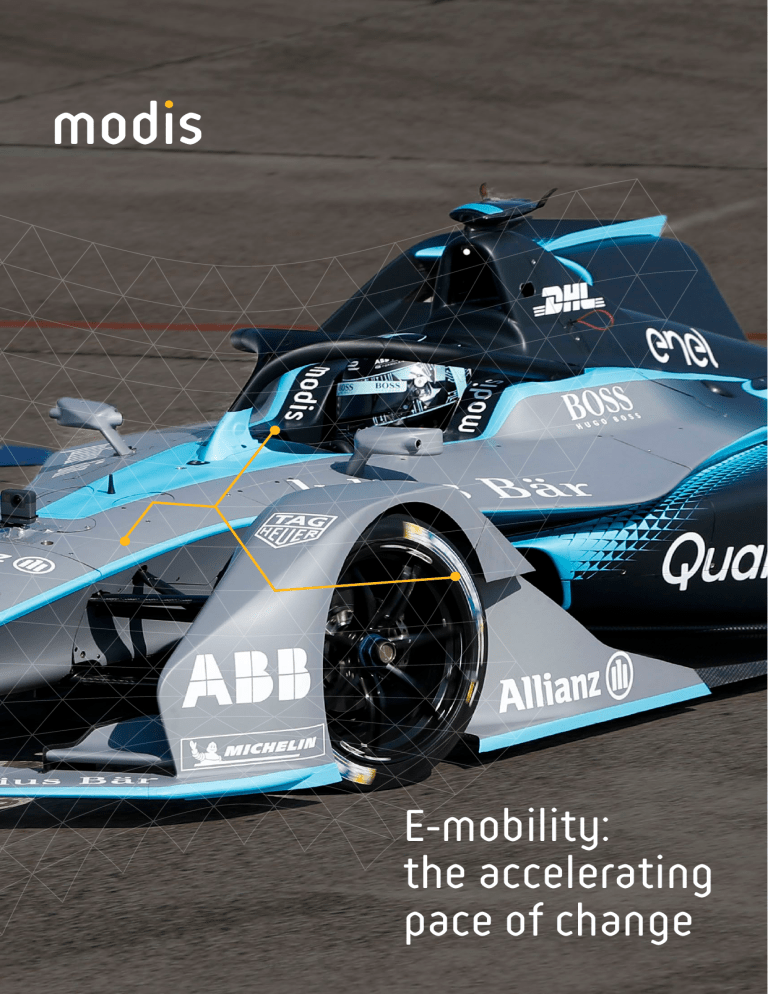
E-MOBILITY: THE ACCELERATING PACE OF CHANGE 1 E-mobility: the accelerating pace of change E-MOBILITY: THE ACCELERATING PACE OF CHANGE Contents 2 Executive summary 5 About the report Section 1: The e-mobility evolution is happening 6 A shift is in progress 8 Strategic responses – placing bets on e-mobility trends 13 Outside industry impacts Section 2: Preparing for the unknown 14 15 16 17 A confident industry Traditional and resilient players Future-proofing Software platforms: to build or borrow? Section 3: Tech, employment, partnerships – tools for success 19 20 21 23 23 Attracting the talent Skills gap ahead In-house development Partnering across the aisle Conclusion: It’s only the beginning 1 E-MOBILITY: THE ACCELERATING PACE OF CHANGE 2 EXECUTIVE SUMMARY E-mobility – the proliferation of electric vehicles (EVs) – is having a profound effect on the automotive sector and its adjacent industries. The scope of its impact is only just beginning to take shape but will, undoubtedly, irrevocably change the market. A combination of regulatory pressure, public demand, and a swathe of new market entrants disrupting the industry mean that change is not only inevitable, but is happening now – and happening fast. shared ownership of vehicles over traditional individual ownership. These common assumptions – firmly in the realm of science fiction just a decade ago – now underline new e-mobility strategies. Managing this transition will be crucial. Those who miss the target completely may risk as much as those who do not innovate at all. Keeping pace with the rate of innovation – along with finding the new skills and insights that will be Three years ago, e-mobility was a strategic consideration for required – is no simple task. So how do businesses decide less than a quarter of companies in the automobile sector. on a strategy when the future is unclear? And how can Insights from industry insiders indicate that this figure is companies acquire and build the skills and technologies they rising to nearly two-thirds over the next three years. Few need to respond? technologies have proved as effective or as fast at shaking up an industry. To address these questions, this Modis report delivers insights from a wide-ranging survey of automotive Where is this leading the sector, and what’s next? Past executives, along with viewpoints from industry experts and predictions of e-mobility trends have rarely played out within academics. It aims to better understand how far along the the estimated timelines. However, many feel confident that, automotive industry is on its transition to a world dominated within the next five to 10 years, autonomous vehicles will by e-mobility – and the confidence levels of those within an dominate the roadways, and that consumers will prefer industry sector marked by disruption. E-MOBILITY: THE ACCELERATING PACE OF CHANGE Some of the report’s key findings include: 3 That is a striking shift. Shared-ownership models of autonomous cars will also put the value stream of cars into question, explains Sebastiaan Change is already well under way in the global automobile industry, but is set to accelerate Krol, CEO of Modis Germany. “The challenge in this is that car manufacturers are increasingly trying to customise their service and entertainment offering to the passengers inside The pace of change has increased rapidly. Nearly two-thirds autonomous vehicles. If the passengers keep changing, it (64%) of survey respondents believe that e-mobility will have creates new opportunities for both the car manufacturers a major impact on their organisation’s strategy over the next and for potential providers of software and entertainment three years, compared with just 24% over the last three years. solutions.” Notably, around one-third (32%) say that their company has already adopted a wholly new business model in response to e-mobility trends. These findings hold across the industry, regardless of company size in terms of revenue or geographic location. Nearly seven in 10 (68%) survey respondents believe that EVs will fundamentally change revenue and value streams for the automotive sector. There is a sense of urgency – for those that don’t adapt and embrace these changes, competitive advantage will have been lost. The industry is optimistic about its ability to navigate the changes, but major strategic questions remain Many of the traditional market players will see huge competition from small start-ups. Start-ups are often better and quicker at acquiring the skillsets to build the cars of the future, and can be more agile than the big players, explains Mr. Krol. Today, there is a growing proliferation of new market entrants set to challenge the incumbents. Delivering autonomous vehicles is now the number one driver of change in the industry, highlighting the extent to which the industry has become a software play Yet the incumbent automotive industry remains confident in Driven by rapid technological advances over the past decade, of the market, or the source of the greatest future revenue autonomous vehicles are now a driving force in e-mobility transformation. The survey shows that strategic planning its future. Nearly nine in 10 (88%) say that their company has a clear vision for their e-mobility strategy, with 85% stating that they are well positioned to execute on that strategy. This is despite continuing uncertainty about the future shape streams. Strategies will need to be robust and agile enough to adapt and cope with future uncertainties. and research and development (R&D) efforts are focused on this area more than any other. Just over half of those polled believe that there is already strong and growing public demand for autonomous vehicles. Distinctions between traditional industry roles are blurring. This will require creativity in strategic thinking The rise of autonomous vehicles means that traditional revenue streams based around cars, car dealerships and “Defining the edge of the industry is becoming more difficult. replacement parts, will become less significant. It’s a lot more blurred than it used to be,” says Professor As witnessed in the smartphone industry, software and Peter Wells, Head of Logistics and Operations Management services are expected to become a bigger source of Section, Professor of Business and Sustainability, Cardiff automotive industry profits than the underlying vehicle Business School. The rise of EVs has opened the door to hardware – a view shared by 68% of industry executives. major new players in the market from the IT, telecoms and energy sectors. The media and advertising industries see the E-MOBILITY: THE ACCELERATING PACE OF CHANGE 4 potential that autonomous vehicles will bring for new revenue skills, making it the most popular option. streams. In addition, in-house development will become a growing and Established players are experimenting and dipping their key part of the corporate strategy to fill the widening skills toes into new areas such as vehicle security and artificial gap: about four in 10 (42%) consider training and mentorship intelligence (AI). Meanwhile, unlikely partnerships with of existing staff as key to obtaining the necessary technical competitors are being considered in order to meet the skills required for e-mobility. However, nearly four in 10 (36%) demand for the technical skills and know-how required express uncertainty about the ability of their organisation to embrace e-mobility. A market in flux presents both to develop new skills and expertise for e-mobility. This is opportunities and challenges in equal measure. important: e-mobility strategies will only be as effective as the talent available to implement them. Software is key to future-proofing business strategies Most respondents feel that their companies’ success in adapting to e-mobility trends will mainly depend on greater adoption of new digital technologies (64%) and development of internal knowledge and skills (58%). Both of these priorities directly reflect a common theme for the future of e-mobility: hardware will take a back seat to software and services. About the report The research is based on a survey of 250 business executives within the automotive industries, spanning Asia Pacific (China, South Korea, Japan and India), Europe (UK, France, Germany, Spain and Italy), and North America (USA). The survey results make the software shift abundantly clear. Already, more respondents feel that their business is more driven by software and services than those who remain purely hardware players. And this will only increase: looking ahead, 57% say that their business will be focused more on software and services in three years than it is today. As hardware elements become more generic, automotive producers will differentiate themselves through their ability to provide more sophisticated software functions. Talent development is a pivotal barrier to success Survey demographics The survey focuses on a wide range of senior executives. Respondents range from the managerial level (40% of overall respondents), to director and C-suite – including chief executive, chief financial officer, chief operating officer and chief information officer – (24%). Respondents all work within the automotive industry. Subsectors represented in this survey are: car-pooling /sharing services, engineering, product development/research/design, financial services, manufacturing (automobiles and parts), Access to skills and talent is one of the most significant marketing services, maintenance and repairs, retail and sales, hurdles for the e-mobility revolution. Nearly all companies software development and implementation, research and are seeking new hires with skills such as AI, application information services. All respondents represent organisations development, and cybersecurity. However, it is widely with an annual global revenue exceeding US$500 million, with acknowledged that demand for talent is outstripping supply. four in 10 (40%) exceeding US$1 billion. Half of all companies surveyed see hiring new talent as the most important means to obtaining the requisite technical E-MOBILITY: THE ACCELERATING PACE OF CHANGE We would also like to thank the following people who took the time to contribute their insights to this report: • Renato Bisignani, Director of Communications and Partnership Activation, Formula E • Yves-Marie Boissonnet, Global Head of Engineering Practice, the Adecco Group • Sebastiaan Krol, CEO Modis Germany • Dr. Walter Leal, Professor of Environment and Technology, Manchester Metropolitan University • Dr. Paul Nieuwenhuis, Co-Director of the Centre for Automotive Industry Research, and Co-Director Electric Vehicle Centre of Excellence, Cardiff Business School, Cardiff University • Professor Peter Wells, Head of Logistics and Operations Management Section, Professor of Business and Sustainability, Cardiff Business School, Cardiff University 5 E-MOBILITY: THE ACCELERATING PACE OF CHANGE 6 SECTION 1: The e-mobility evolution is happening “As customers, we are changing,” says YvesMarie Boissonnet, Global Head of Engineering Practice at the Adecco Group. Just as the way we consume movies and music has been disrupted by the likes of Spotify and Netflix, the way we drive is being altered by the development of EVs, autonomous cars and shared mobility. “Moving from point A to point B will be totally disrupted,” Mr. Boissonnet says. A shift in progress Almost two-thirds (63%) of executives within the automotive industry agree that the automobile industry has been slow to respond to the issue of e-mobility, but that they expect this will change sharply in the next three years. A number of factors are pushing the rapid rise of e-mobility disruption. Regulatory pressure and public demand are pressing the automotive industry to clean up its act with respect to transport pollution, now responsible for about a quarter of greenhouse gas emissions. In addition, a range of What’s more, customer preference is shifting. “The focus new market entrants are pushing the bar on innovation and of buying a car is drifting away from the pure performance new business models. of driving and more towards entertainment and experience within the car,” explains Mr. Krol. And, because of the speed at The industry-wide change is disrupting business models which cars are becoming digital, manufacturers’ demand for across the sector. Looking ahead over the next three years, external software and services expertise is booming. “This 82% of survey respondents say that they are facing major market is opening up because, internally, manufacturers are or moderate strategic impacts on their businesses due to overwhelmingly staffed with people who were hired when car e-mobility, far more than in the past three years. This finding design was mostly a mechanical undertaking.” holds across the industry, regardless of company size or geographic location. E-MOBILITY: THE ACCELERATING PACE OF CHANGE 7 Over the past three years, to what degree has electro mobility (e-mobility) impacted on your organisation’s overall strategy? And how much do you expect it to impact on your strategy in the next three years? Figure 1: The impact of e-mobility This is largely because traditional revenue models and the value stream from internal combustion engine cars do not transfer well to a market dominated by EVs. “The existing industry business model has probably reached the end of the road anyway,” says Dr. Paul Nieuwenhuis, Co-Director of the Centre for Automotive Industry Research and Co-Director Electric Vehicle Centre of Excellence at Cardiff Business School. “If you then throw new technologies like EVs into the mix, the whole thing no longer works.” For example, traditional income for car manufacturers has mainly stemmed from initial car sales, support from corporate finance, spare parts, service and maintenance. Franchised dealers also play a large part in this infrastructure. With EVs, these income streams will be turned on their heads. Many survey respondents believe that EVs will fundamentally change where auto sector companies capture value. For example, as seen in the smartphone industry, 68% believe that software and services will become a bigger source of automotive industry profits than the underlying vehicle hardware. In addition, 61% agree that shared mobility models will emerge as common replacements to traditional car ownership over the next three years. E-MOBILITY: THE ACCELERATING PACE OF CHANGE 8 To what extent do you agree or disagree with the following statements? As seen in the smartphone industry, software and services will become a bigger source of auto industry profits than the underlying vehicle hardware. Shared mobility models (e.g. on demand and pay per use) will start to emerge as increasingly common replacements to conventional car ownership over the next three years Figure 2: Shared mobility models, software and services Strategic responses – placing bets on e-mobility trends The transition to e-mobility will certainly not happen overnight. Most manufacturers, engineers, suppliers, product development firms and other players in the industry will continue to service and develop traditional cars and hybrids for decades to come. However, R&D for EVs is a growing part of their business models. This survey shows that, for nearly all respondents, the rise of e-mobility has caused organisations to place more critical consideration on EV-related strategies in the past three years. Notably, about one-third (32%) say that their company has already adopted a wholly new business model in response to e-mobility trends. And experimentation with related e-mobility projects is well under way. E-MOBILITY: THE ACCELERATING PACE OF CHANGE 9 In the past three years, in response to the rise of e-mobility, has your organisation placed more critical consideration on any of the following strategies? Has your organisation participated in any trials and experimentation in the following technology and service areas: Figure 3: The rise of e-mobility E-MOBILITY: THE ACCELERATING PACE OF CHANGE Autonomous vehicles “ When asked which e-mobility strategies are receiving the greatest consideration, it’s clear that autonomous driving is a priority. Driven by rapid advances in various technologies over the past decade, it is now a driving force in the e-mobility transformation. “In 10 years all our streets may be full of autonomous car taxis, and that will definitely have an impact on the production of cars, the number of cars sold globally and how they are financed,” says Mr. Boissonnet. Just over half (51%) of the industry professionals polled believe that there is already strong and growing public demand for autonomous driving vehicles. And nearly half (49%) pointed to the development of autonomous cars as a critical part of their current strategy. Given that delivering autonomous vehicles is primarily a software challenge rather than a hardware issue, this is a seismic shift. Business strategies are already honing in on autonomous driving: 38% say that their company is already involved in trials related to autonomous driving – making this the top technology area of investment with the rise of e-mobility. Of those who are already investing, 63% say that autonomous driving best reflects their key strategic priorities in relation to e-mobility. “The whole hype around electric mobility is giving great impulse to aim for autonomous cars,” says Dr. Walter Leal, Professor of Environment and Technology, Manchester Metropolitan University. Although there are still many safety and regulatory concerns surrounding fully autonomous cars on the road, degrees of automation are already on the market, and incremental implementations are increasing rapidly. “The car I drive warns me if I am going too much to the side of the road or if there are obstacles ahead, with a gentle vibration 10 of the steering wheel,” he adds. “As technology improves and becomes more reliable, our vehicles will become increasingly automated. And in terms of becoming fully autonomous, I don’t think that will be far ahead in the future.” New sources of energy New energy storage solutions are the second most quoted area of experimentation and the fourth most popular strategic consideration made in the past three years. This is another area that holds major implications for current business models. “The whole EV [shift] breaks down if the energy charging the car comes from conventional power sources,” says Dr. Leal. “If we are using coal, nuclear, thermal or other polluting power sources, then emission savings won’t be taking place. We need pure renewables to make it work.” Some players have been quick to see the opportunity. Tesla, for example, has merged with a solar power generation company, thus integrating the sale of batteries and solar panels alongside its vehicles. Many other players are also jostling for attention in this space. “Battery charging is an area of particular focus at the moment,” says Renato Bisignani, Director of Communications at Formula E, a major global electric racing championship and sporting platform for manufacturers to test and showcase their EV technologies. “The range and autonomy of batteries is already at a very advanced stage, even if we are in the early stages of EV development, and that will continue to grow. How quickly the batteries will be recharged will further accelerate the adoption of EVs. Furthermore, as technology progresses and sale prices start to align with traditional combustion cars then the choice for consumers will be very simple.” Mr. Bisignani adds that, in the space of just four years at Formula E, cars have managed to double their energy capacity. “Formula E is proving how fast EV technology is developing, with our newly launched Generation2 car making its debut in season five and able to run the entire race distance with no need for drivers to have a mid-race car E-MOBILITY: THE ACCELERATING PACE OF CHANGE swap. The technology transfer from track to road will benefit the automotive industry as a whole.” For everyday drivers, this translates to longer road trips and less ‘range anxiety’ about reaching the next charging station. 11 Shared mobility About six in 10 of respondents agree that shared mobility models, such as on-demand or pay-per-use vehicle sharing models, will emerge as increasingly common replacements Charging infrastructure to conventional car ownership over the next three years. Accordingly, this is a key priority for the majority of respondents (68%) in relation to their e-mobility strategy. The infrastructure and availability of charging networks are However, to date, only 19% have started experimenting with without doubt the key bottlenecks to EV transformation. Our related models, indicating how much more work remains to survey shows that 41% have given more critical consideration be done in this area. to the approaches and models for vehicle charging and refuelling in the past three years. And nearly a quarter have already participated in trials related to charging networks and vehicle charging. “ Today, if you buy an electric car for the typical urban mobility purposes, it’s probably parked about 90% of the time,” explains Mr. Krol. “Longer charging times of more than several hours are not a problem in this case”. For the actual purpose of a car however, mid to long term travel, the ranges of the current vehicles oblige you to regularly stop to power up. In these cases you need fast charging, say half an hour to an hour maximum. So we need high and low-speed charging possibilities built into our traffic infrastructure. I do not yet see people thinking structurally enough about the architecture and infrastructure that is needed in my opinion; work is overly focussed on charging within the urban and suburban areas but not the actual car or travel experience.” At the end, the future can’t be parking lots aside the freeways covered with hundreds of different OEM Specific charging poles. Diversification and integration Companies are not placing all their eggs in one basket. Many respondents say that they are involved in several facets of e-mobility. A quarter have already started trials on updatable cars and advances in car connectivity, as well as 3D printing for vehicle parts, vehicle cybersecurity, charging networks, and artificial intelligence. Some models, such as Tesla’s model S and Nissan’s Leaf, are developing high levels of integration across many of these technologies. While some elements may prove to be profitable, those that are not can be divested at some point in the future. There is a precedent within the industry for such an approach, says Dr. Nieuwenhuis. The production of Ford motor cars was initially done entirely in-house, in part because there was no infrastructure of external suppliers big enough to feed Ford’s mass production system. Gradually, the industry changed. Today, it is estimated that Ford subcontracts 60–70% of the activities once done inhouse. “At the moment we’re entering a period of intense experimentation, and one of the responses to that is to start doing everything, and gradually start separating things out,” says Dr. Nieuwenhuis. E-MOBILITY: THE ACCELERATING PACE OF CHANGE Outside industry impacts The car manufacturers are only a small part of the EV value chain. Many industries have a role, arguably a responsibility, and indeed opportunities to seize, around the e-mobility transformation. Energy One key benefit of e-mobility is that it reduces our dependency on oil. Alternative sources of energy and the infrastructure for EV charging are now main considerations in the future development of EVs. Many traditional and new players are involved in this movement to clean, abundant energy. Supplying electricity that is green and sustainable is a significant challenge that will also have a tremendous impact on the traditional energy sector. IT and consumer electronics The physical car is only a very small part of the e-mobility evolution. As this report shows, software and services are expected to be a bigger source of automotive industry profits than traditional hardware. A variety of players outside the automotive industry will provide the core platforms and new services to support and push this shift. Engineers and app developers will be needed more than ever, in many roles and industries, to bring the possibilities of EVs to life. Media and entertainment “Soon, you will not sit in a car the way that you are sitting today,” says Mr. Boissonnet, referring largely to the steady emergence of self-driving cars. “There are definitely new potential revenue streams for the media industry and for the advertising industry.” Currently drivers are not able, or certainly not advised, to engage with media interfaces that might impair their concentration while driving. But truly autonomous cars paint a different picture. Riders become a captive audience, available for music, movies, and TV shows. Accordingly, media players are keeping a close eye on this space and potential opportunities to partner with manufacturers. “This whole process has a lot of spinoffs, different parts that involve other sectors,” agrees Dr. Leal. 12 E-MOBILITY: THE ACCELERATING PACE OF CHANGE 13 E-MOBILITY: THE ACCELERATING PACE OF CHANGE 14 SECTION 2 Preparing for the unknown A confident industry When it comes to confidence, the automotive industry has it in copious supply, no doubt bolstered by strong sales in recent years. Nearly nine in 10 respondents (88%) say that their company has a clear vision for their e-mobility strategy. Furthermore, 85% say they are well positioned to execute on that strategy. handle this change and just to see what works,” says Dr. Nieuwenhuis. “The shape of the industry in three to five to 10 years’ time is unknown, and some business strategies may not be robust enough to survive a slow pace of adoption, or agile enough to meet surging demand. They may be investing in the wrong strategies.” There are also significant unanswered questions around the extent to which the EV market will grow and the revenues It is interesting to note that these levels of confidence are it will generate. The strategies will need to be creative to industry-wide, regardless of size, sector and regions: strong cope with the level of uncertainty. And, while most business confidence is reported by 89% of respondents in Europe; 88% executives are bullish about their strategies and ability to in Asia Pacific; and 84% in North America. execute, nearly one in two (46%) express some hesitation about their ability to execute on the shift to e-mobility. At first, this confidence may seem misguided. “Companies are experimenting with different business models to E-MOBILITY: THE ACCELERATING PACE OF CHANGE 15 In your view, does your organisation have a clear vision for Is your organisation well positioned to execute on that its e-mobility strategy? strategy? Figure 4: Executing an e-mobility stragegy Traditional and resilient players Regardless of the uncertainty around e-mobility strategies, three global manufacturers would enter the series by season optimism prevails. And despite a proliferation of well-funded five. We are in the middle of our fourth season and have newcomers in the market that might shake the resolve of already announced 11 global manufacturers with the recent industry incumbents, most respondents believe that today’s entries of Mercedes and Porsche.” leading car manufacturers will be able to maintain market dominance in the next three years. “I share that confidence,” says Adecco Group’s Mr. Boissonnet. “In order to push all that innovation and change, the main driver is equity. You need strong equity to stay relevant in that market. So I would say traditional car manufacturers should be confident.” They also adapt well to new entrants, he adds. “E-mobility has triggered many manufacturers to launch EVs and enter the market. And newcomers may take some of the market share but the establishment continues to dominate.” Formula E’s Mr. Bisignani has also seen a massive surge of involvement by traditional players. “When Formula E was launched in 2014, we did not expect the rise of EVs to be so imminent,” he says. “Our original business plan forecast that Future-proofing The strategies and decisions made over the next five years will guide e-mobility for the next 20, especially in respect of planning charging stations, infrastructure, and incentives for buyers. It is therefore important that automotive companies don’t miss the mark. “If we don’t get it right in the next five years, we won’t get it right at all. So the decisions and investments need to be made now or it won’t work at all,” says Dr. Leal. Most respondents feel that, to successfully adapt to e-mobility trends, they must depend on greater adoption of new digital technologies (64%) and development of internal knowledge and skills (58%). E-MOBILITY: THE ACCELERATING PACE OF CHANGE 16 In which areas do you believe your company has to adapt and/ or develop in order to cope with the e-mobility-related changes in the auto industry over the next three years? Figure 5: Adapting to e-mobility Both of these priorities reflect a common theme: hardware increasingly commoditised. The points of differentiation will will take a back seat to software and services. This shift become the structure of the vehicle and the way its different towards software is abundantly clear throughout the survey. software elements function. More respondents say that their business is driven by software and services than those who believe it is primarily “I think that, in order to differentiate in the future, you need driven by hardware. Looking ahead, 57% say that their software expertise. You have to be able to work through business will be focused more on software and services in software to configure suspension, how the car behaves in three years than it is today. “This doesn’t surprise me,” says terms of performance, responsiveness and acceleration, Dr. Nieuwenhuis. The emphasis on software addresses one and how that interacts with the electronics in the car,” says of the key problems the industry will have around how to Dr. Nieuwenhuis. Besides, he adds, “hardware is often where differentiate their products and services. we see things go wrong. Just look at Tesla trying to wrap up production for the Model 3. Their current difficulty is around At the moment, big auto producers differentiate themselves through physical elements like engine performance, driver handling and electric motors. But these factors are controlling the hardware.” E-MOBILITY: THE ACCELERATING PACE OF CHANGE 17 Which of the following business models will best represent your organisation in three years’ time? Figure 6: Future business models Software platforms: to build or borrow? More than half of respondents (54%) agree that their company will focus more on implementing software platforms provided by partners (e.g. Google, Apple) than developing their own. Only 18% disagree. However, the picture is not straightforward. “It is extremely tricky to figure out what is the best way to achieve a balance between build or borrow,” says Professor Wells. Agree or disagree: we’ll focus more on implementing software platforms from other partners (e.g. Google, Apple) than developing our own. Figure 7: Focus on software E-MOBILITY: THE ACCELERATING PACE OF CHANGE 18 A key concern for the industry is who owns the customer and Outsourcing media seems a strategy adopted by almost all the data that customers generate. Both are valuable. Most businesses surveyed. It is accepted that there is little point car manufacturers are reluctant to hand that key relationship in competing with the Apple Music, Spotify, and Netflix-type over to the software and services industry. services of the world. “What I’m seeing is an attempt to define new sorts of bundles whereby companies are trying But as this survey shows, a decoupling of software from to position themselves and the car as a collective resource hardware is largely already under way or, to some degree, management strategy for households,” adds Professor accepted as the ideal strategy. The controls and interior Wells. An example is Tesla’s Powerwall, a home solar energy interface are increasingly digital and complex. The total storage hardware unit that can be used to charge electric software systems running in an EV and an autonomous car cars. “The car is increasingly linked in terms of information are immense: information, vehicle control, entertainment, sharing. That’s one way forward at an individual household security and beyond. Furthermore, it is important for level, but difficult to achieve in a significant volume in a short producers to ensure compatibility while having the scalability amount of time.” and flexibility to switch out or update software without interfering with the hardware or the car’s functionality. Others are taking a more piecemeal approach, such as Jaguar’s removable steering wheel, an interface you can take Few manufacturers have the resources and expertise to cope with you as a smart mobile device or music player. “Looking with this complexity. “They are probably going to chew much at the whole picture, I see a dance between big industry more than they can swallow if they engage on building their players in automotive and IT and so on, all forming little own. So much investment is necessary and then they will alliances and groups and clusters,” reflects Professor Wells. be competing with more powerful tech companies,” says Dr. But, he warns, there is no guarantee that these alliances will Leal. endure. https://techcrunch.com/2017/09/07/jaguars-new-concept-has-a-steering-wheel-you-talk-to-and-take-with-you E-MOBILITY: THE ACCELERATING PACE OF CHANGE SECTION 3 Tech, employment, partnerships – tools for success Undoubtedly, a significant number of traditional jobs in the automotive industry will be impacted upon by the transition to EVs. But many new job opportunities are emerging in nearly every sector as a result of the shift. Suppliers developing lightweight materials, batteries, robotics, and the systems, software and services that run EVs are a clear example of growing and in-demand sectors that require engineers and skilled workers to meet evolving needs. Attracting the talent According to survey respondents, the top skill sets that the automotive industry plans to recruit include app development, AI, cybersecurity, robotics, systems engineering, and cloud computing. The procurement and development of knowledge and skills related to e-mobility trends will be the most defining and challenging part of the e-mobility evolution for the automotive sector and the industries adjacent to it. 19 E-MOBILITY: THE ACCELERATING PACE OF CHANGE 20 Which specialty skill sets do you believe will be most important for your organisation to employ in greater numbers over the next three years in order to best meet future needs? Figure 8: Speciality skills of the fuuture In terms of attracting talent, many players have done well There are, however, other draws for skilled professionals, for themselves. About eight in 10 report being somewhat including career development and business incubation. or very successful in hiring their most in-demand skills to “Volkswagen is big on this at the moment,” says Professor date. Automotive companies are recruiting at an incredible Wells. “They’ll provide modest funds for a range of small rate, but as they do so, they’re increasingly competing with companies to develop ideas and allow them the time and the Googles, Ubers and Facebooks of the world for talent, space to be creative around these new technologies with the especially in the realm of AI. With such scarcity of talent, view that [the] car companies, benefit in the longer run.” companies are making eyebrow-raising offers – average salaries in the US for AI-related programmers are in the US$300,000–500,000 range, with some individuals taking home tens of millions of dollars. [ 2 ] When competing for top talent, money talks. The survey finds that, the greater the annual global revenue of the respondent company, the more likely the business representatives were to say that recruiting efforts have been “very successful”. Professor Wells isn’t surprised: “There’s been a long-running tradition in big industry in need of new capability, resources, materials or whatever: flex financial muscle.” Skills gap ahead No amount of incentives can fix the underlying problem: There is not enough talent to go around – not yet. The talent war is just getting started, notes Mr. Boissonnet. “We are going to need engineers of all kinds in the future to satisfy the demands of the industries. And by 2020, over 50% of the engineers needed will be software engineers.” [ 2 ] https://www.nytimes.com/2017/10/22/technology/artificial-intelligence-experts-salaries.html E-MOBILITY: THE ACCELERATING PACE OF CHANGE Existing universities are able to satisfy some of this future demand, but it is not a perfect solution. “Universities are always a generation behind,” says Dr. Paul Nieuwenhuis, “and that’s a problem. They don’t have the resources to keep up with the very rapid development taking place in industry and business.” Additionally, according to Dr. Leal, not many universities are offering engineering programmes geared toward building EVs. For example, AI is not considered to be a core element of engineering training, but is key for EV specialists. “Another problem is vehicle repair and maintenance. Most mechanics do not have the skills or tools – or qualifications – to assess what has gone wrong with an electric car and how to fix it,” he says. EV repair will probably require a higher, or at least different, level of skills than the average vehicle mechanic possesses. “The types of skills needed are quite different from those we have today,” adds Dr Nieuwenhuis. “People may be able to make the cars, but can we get them fixed?” Unfortunately, the skills gap will widen as the needs of the industry grow. Without the depth of talent that cuts across the whole automotive ecosystem, the progress of EVs may falter, with consequent ramifications for the economy and environment. In-house development It will take many years until the supply of skills needed meets the demand. In the meantime, organisations are pushing for new hires and in-house training, The survey finds that many companies are relying on their ability to develop talent internally for e-mobility (42%). Many respondents are bullish that their company’s ability in this regard is strong, but only a minority (18%) rate their company’s ability to do so as “extremely strong”. This strength will be further tested as the industry competes with a different set of players to attract and retain tomorrow’s talent. 21 “ “I think it is important that companies work to develop the e-mobility skills of their staff,” says Mr. Krol, “Many have staff with skillsets close and viable to the new skills needed. But I also think it’s important to recognise that a part of this population will not have the right skillset, or simply not be interested in adapting from a mechanical focus to a digital one.” E-MOBILITY: THE ACCELERATING PACE OF CHANGE 22 Which of the following will be most important to your organisation in supplying the necessary technical skills required for e-mobility? How strong or weak is your organisation in terms of its capability to internally develop new skills and expertise in relation to e-mobility? Figure 9: Attracting talent and developing skills Mr. Krol adds that many digital start-ups readily have staff with desired skillsets, and acquiring them may be faster than developing in-house. And indeed, there is at least some recognition of a shift under way: fully one in three (33%) believe that acquisitions of companies with specialised e-mobility areas will be the best way to access the necessary skills. E-MOBILITY: THE ACCELERATING PACE OF CHANGE Partnering across sectors and with competitors 23 streams from things like in-car entertainment and media systems and so they’re looking at start-ups and outside industries for adjacent services to the car, and to see what secondary revenues can be made once driving the car is no A significant number of companies will be seeking new forms longer the primary reason you buy a particular car.” of partnerships – with complementary companies like energy firms and software companies (38%), direct rivals (32%) and universities (25%) – to access the e-mobility skills they need. “ When you think about partnerships, consider that big companies often lack the skills necessary to develop the next generation of cars, explains Mr. Krol. The big players are searching for skilled labour and resources externally, and these partnerships are one of their main means of accessing them. “Building the resources internally would be preferred, I’m sure, but they form these partnerships with other companies to make sure they can stay competitive.” Conclusion: It’s only the beginning E-mobility brings with it major transformations, including a cleaner, more sustainable and easier way to travel from A to B. But to get there, the whole industry will need to change. This is an historic move, and experts believe that the sector is on the edge of a new industrial revolution. This is driven in part by a shift to new and cleaner sources of energy. It is also prompted by unexpected rapid changes in autonomous vehicles, which have gone from science fiction to science fact in a short time. Finally, a generation of young people are questioning the merits of buying and maintaining a physical asset when they can more easily request one on demand via their smartphones. Of course, given the scale of transformation ahead, this Over the past three years, new partnerships between will not be easy for the industry to cope with. A century of companies have become increasingly popular, both within development and refinement have seen today’s vehicles (44%) and outside (35%) the automotive sector. become fantastically well-engineered machines, but tomorrow’s winners will increasingly be those that are able Outside-industry partnerships are hardly a surprise. Car to adapt their business models and skill sets to the reality manufacturer are already thinking about autonomous of the technology sector. Right now, sustained and robust vehicles and what offerings they can sell to customers keep sales from traditional businesses is masking the scale of them occupied, Mr. Krol explains. “There are potential revenue the shift for carmakers. However, the pressure to adapt will increasingly ramp up in the coming years. Thank you for reading If you would like to find out more about the future of e-mobility and its impact on the jobs market, or our full range of services, please contact us. media@modis.com www.modis.com https://www.linkedin.com/company/Modis E-MOBILITY: THE ACCELERATING PACE OF CHANGE 24
